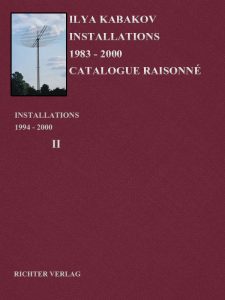Unfinished Installation
YEAR: 1995
CATALOGUE NUMBER: 84
PROVENANCE
Collection of the artist
NOTES
See No 90
EXHIBITIONS
Johannesburg
Africus. First South, 28 Feb 1995 — 30 Apr 1995
Hamburg, Deichtorhallen
Ilya Kabakov. Der Lesesaal – Bilder, Leporellos and Zeichnungen, 19 Apr 1996 — 28 Jul 1996 (as part of No 90, The Reading Room)
DESCRIPTION
The viewers stand before low ‘barriers’ comprised of crates, boards, tied off ropes. Beyond the ‘barriers’ is an ordinary scene of something that is not yet ready: opened packages, crates, a few paintings hung, a few leaning up against the wall. All kinds of details and things scattered around, the meaning of which is not yet clear. Tools are lying around, rulers, jars, paint …
On one of the crates of the ‘barrier’ is a plan and a photograph of what ‘will’ be built here. And herein lies the very essence of the installation.
Everyone knows from their own experience that looking at a building under construction is much more interesting than looking at a finished one, especially if one can see the plans of what ‘will be.’ The process of comparing what ‘is’ and what ‘will be’ is captivating; it is simply impossible to tear oneself away.
Oh, if only the builders and artist would return right now and finish the installation! Where in the hell are they? Why aren’t they finishing it?!!
CONCEPT OF THE INSTALLATION
In the space where the works of other artists have already been hung up and placed all around (the exhibit has already begun and there has already been an opening), one corner is absolutely unfinished, everything is scattered all about and there is a collection of things that are not connected: crates, ladders, boxes, both empty and with some things inside, stacks of cardboard and paper, paint and other such junk. One gets the impression that the construction of some installation was begun here, but everything stopped somewhere in the middle. But all of its ‘details’ have already been unpacked and are lying on the floor. It is only the author’s idea that remains incomprehensible – what will emerge when he finishes his work. This is precisely what attracts the viewers’ attention. They stand at an improvised barrier made of crates and boards and try to figure it out, glancing at the plans and sketches lying on these boards left by the builders. The viewer’s curiosity is similar to that of a passerby who has paused on the street, having tilted his head back, and who is watching the construction of a new building.
The installation belongs to the ‘parasitic’ ones; i.e. its existence is connected with the completed arrangement of other paintings in the same hall. In contrast to the already finished works nearby, ‘time’ exists in this installation, because nothing attracts one’s attention more than something not yet done, but that apparently will be finished soon.
I experienced and verified this ‘effect’ completely by accident when I was erecting the installation ‘Before Supper’ at the Venice Biennale in 1988. In the enormous halls of the Corderia where the exhibit was held, everything was ready for the opening. All the installations of all the other artists had been finished but mine, and there was just the unfinished white wall where everything was supposed to be hung, and a formless heap of crates, paintings, some sort of constructions, boards … And I clearly remember that nowhere was there such a crowd of curious visitors as there was near this disheveled heap. They looked over every object, examining the plans lying right there, asking questions …
Now it seems to me that if I had then erected an ‘explanation-board’ about what was going to be built here, that would have turned out to be sufficient for achieving the entire concept…
Images
Literature




